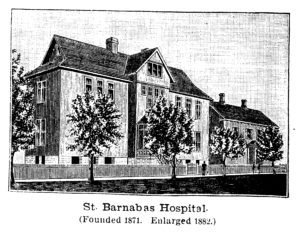
It was originally printed in the St. Barnabas Annual Report from 1884. The original Cottage hospital is the smaller wing on the right-hand side of the building. The larger portion is what turned the Cottage Hospital into St. Barnabas.
By Sue Hunter Weir
Before health care was big business and before it became a political hot button, it was a charity. The first hospital in Minneapolis, the Cottage Hospital, opened its doors in March 1871. Eight of the hospital”'s beds and most of its furnishings were donated by such diverse groups as the Masons, workers in the machine shop at the Milwaukee Railroad, St. Mark”'s Parish, the Ladies”' Aid and the Brotherhood of Gethsemane Church.
The hospital was only one of many charitable causes that can be attributed to the Reverend David Buel Knickerbacker, the rector of Gethsemane Church, who saw a need to build the “Cottage Hospital and Home for the Sick and Friendless.” The population of Minneapolis was 13,000 when the hospital opened but many of the town”'s people were single immigrant men who worked for the railroads and the mills in jobs that were extremely dangerous. The hospital was located downtown close to the mills for precisely that reason””to be near to the places were accidents were most likely to occur. The Cottage Hospital offered horse-drawn ambulance service.
The Brotherhood of Gethsemane raised money for the hospital by offering lectures and concerts, holding festivals, and by appealing to the public for food, money and supplies through the local newspapers. The public responded and each month a list of the donors and their gifts was printed in the paper. For the most part, they were modest gifts: jars of jam, bandages, reading materials, home grown vegetables, eggs, milk and poultry. They also included brooms, blankets, and an occasional gift of medicinal whiskey. Mill owners donated all of the flour that the hospital needed and the railroad shipped carloads of firewood to the hospital at no cost.
It may sound idyllic but it wasn”'t. While the citizens responded to the needs of the poor and helpless, those problems only increased as the city”'s population grew and outpaced the hospital”'s ability to take care of those who needed help. In the annual report for 1880, the hospital”'s superintendent noted that the hospital”'s “”¦capacity has at times been taxed to the utmost, and the city has outgrown the limit of our accommodations. The number of railroads entering here, and the amount of machinery in constant operation makes accidents of [sic] occurrence rendering it necessary to have larger and better accommodation whilst the requirements of the city”'s poor demand more room than we have.”
The hospital accepted private patients who could pay for their own care but the majority of patients were charity cases who fell into one of two groups. The $6.00 a week cost of caring for residents of Hennepin County was paid for by the county; the costs of those who were not residents of Hennepin County were paid for by private charitable donations. The hospital”'s policy never changed: “Our doors have been thrown open wide for the reception of all colors, nationalities and creeds.”
Who were those patients? Each year the hospital superintendent included the number of patients treated, their countries of origin, their religious affiliations, and, on occasion, the reasons why people were admitted. Patients were not identified by name but Sister Annette Relf, nurse and matron of the hospital, wrote short profiles of a handful of the patients. Since the hospital was a mission of a church, it is not surprising that the spiritual healing of her patients was as important to her as their physical wellbeing.
Those brief descriptions, often no more than a sentence or two, are in some cases enough to help identify the people who are buried in Minneapolis Pioneers and Soldiers cemetery.
Three weeks after the hospital opened, the first patient death occurred. He was Cevis Swanson, a 20-year-old Swedish immigrant, who was admitted when “very low from typhoid and pneumonia.” Mrs. William McConnell, an elderly woman, was “blind and consumptive.” Charles Lane was “a wanderer from his home in Maine” who, before he died, “sent loving messages to his wife and child to meet him in heaven.” John Holloway was injured in a cave-in and “lingered in agony for several days” before he died.
Three of the men who died there were Civil War veterans: Horace Blake, Sylvanus Rugg, and Thomas Sandy. Sylvanus Rugg died from kidney disease; Horace Blake and Thomas Sandy died from tuberculosis. Sister Relf described Thomas Sandy, a charity patient, as a “blacksmith, prematurely broken down by dissipation and hard living, who was badly treated and very unhappy in his home.” He was in the hospital for four months before he died.
In 1874, the hospital moved to Elliot Park, and, in 1883, changed its name to St. Barnabas. St. Barnabas continued to operate as a private hospital to 1991. In 1897 the City Council opened City Hospital, a tax-supported charitable hospital in 1881. Many years later it still exists as Hennepin County Medical Center.
There is an African-American man, John Wesley Justice, buried in the cemetery. He died in 1909 from TB when he was only 38. His father was named Isaac Justice. His grandfather, who was born in Virginia in 1837, was named Isaac Hope. So the family went from Hope to Justice.
Tales Trivia while “Digging”
From Hope to Justice
BY SUE HUNTER WEIR
There is an African-American man, John Wesley Justice, buried in the cemetery. He died in 1909 from TB when he was only 38. His father was named Isaac Justice. His grandfather, who was born in Virginia in 1837, was named Isaac Hope. So the family went from Hope to Justice.









